Menus
- Mutation Gelande "Sport"
- Historical
- Discovery: the mouth of employment
- In the saddle
- In the city
- Motorway and expressways
- Departmental
- All Terrain
- Part-cycle
- Braking
- Comfort / Duo
- Consumption
- Conclusion
- Colors
- Options and Packs
- Technical
- Maps
- ASC (Automatic Stability Control) traction control,
- Semi-active dynamic ESA suspension
Mutation Gelande "Sport"
Few machines can be proud of such a prestigious lineage as that of the German trail. At the top of high roads, drivable or not, and success for more than 30 years, the BMW R 1200 GS synthesizes the concepts of performance, robustness and travel. With 450,000 units sold since its inception, including 170,000 1200 cc and 67,000 Adventure versions, the Gelande Straße (path and road) has nevertheless continued to chart the way towards innovation. After the Boxer, Telelever and Paralever revolutions, the maxi trail is approaching, full throttle, a new turn in its career. Now more than thirty years old, the R 1200 GS, in addition to aggressive competition, had to face its major challenge: the future. Indeed, having achieved the ultimate evolution of its air (and oil) cooled core, the mythical "flat" could not respond more to the dynamic demands of the segment and to ever more stringent anti-pollution standards. After many evolutions, an essential change of the Germanic bloc was necessary: the liquid cooling… This is accompanied by many other transformations, of which aesthetics and performance are not the least. To the point of imagining without difficulty a surname Gelande Sport…
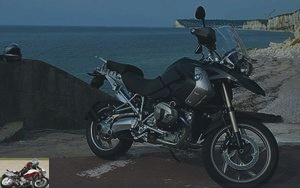
Historical
Marking the spirits since its appearance in 1980, through its success in rallying, the GS has constantly known how to renew itself. Engine and cycle parts have thus undergone profound changes over time. First, R 80, then R 100 GS, the adventurer appears transfigured in 1994 by the adoption of a 4-valve 1100 cc boxer unit but also of a revolutionary cycle part: the rear paralever is associated with a Telelever system at the front, anti-dive guidance principle which sets new road holding benchmarks then and still today.
Becoming always more opulent, efficient and…. heavy, the maxi trail will then evolve into 1150 then 1200 cm3. In 2004, the R 1200 GS then changed again in depth with an even sportier flat twin engine (more than 100 hp and 11.5 m / kg of torque) but above all a major work on weight and size; Engine, gearbox, new cardan arm, new cycle part (larger tubular trellis frame)…. in total, more than 15 kilos lost and an extreme liveliness testify to the progress made: 230 kilos in running order. But already the competition is active to try to overthrow the queen of versatility. In 2010, the Bavarian multi-road reference therefore raised the tone and adopted cylinder heads with double camshaft.
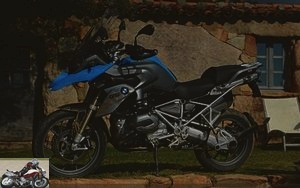
Discovery: the mouth of employment
If the mechanical point is in itself akin to a revolution, we cannot however limit the renewal of the all-way icon to this single evocation. Indeed, the whole machine has been redesigned, both in the architecture of its engine, that of its lines and in the increase of its dynamic capacities. Aesthetically, the new GS clearly announces its increased road ambitions, thus responding to its European rivals. KTM 1190 Adventure and Ducati 1200 Multistrada are clearly warned: no abdication in sight !
In fact, there is a new sportiness in its appearance. Spout, headlight, optical unit support in magnesium and bubble adorn the sharp lines. The projectors themselves incorporate many innovations. If a disconnectable daytime element with automatic or manual ignition can be added to the other two, the most spectacular remains the integral LED option, including a surprising U-shaped daytime running light lying down and even integrating a cooling and demisting system.

Framed by deflectors, fork crown and sidewalls enhance their silhouette, contrasting with an aerial rear loop. In fact, it is especially the addition of scoops dressing the steering gear that we note. This graft hides that of the radiators, notably concealed and provided, at their base, with anti-projectile protuberances. New lateral forced air intakes appear above these appendages. This feeds an intake-exhaust system now placed in a vertical position and immediately identifiable, an outward sign of the deep internal renewal of the flat twin..
Particularly highlighted by the darker-colored cylinder head covers, the twin-cylinder imposes refined shapes and clearly perceptible robustness. Purists will appreciate the conservation of a few large fins on the block. More than half of this aesthetic symbol is involved in cooling, always combining the two principles of air and liquid. The circulation of the calorifier is concentrated only on the hot spots of the "flat" and mainly the cylinder head. A marketing highlight, this important difference with the old model almost masks other essential points. Bore and stroke do not change (101×73) but the compression ratio increases (12: 1 to 12: 5), as does the diameter of the valves (+1 mm). New camshafts and crankshaft lightened and stiffened, 52 mm injection (50 before), simple vertical gas flow ignition and optimized exhaust line with motorized valve for an assertive sound signature.
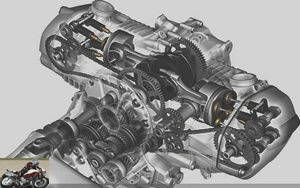
The narrow silencer and provided with a double black ratified exit also passes on the right side. These are the real strengths of the 2013 twin, now delivering 92 kW (125 hp) at 7,700 rpm and 12.5 da.Nm at 6,500 rpm (+15 hp and 0.5 unit of torque than the old one. vintage).
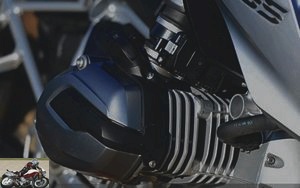
And the change does not stop there. The crankcase now incorporates the six-speed gearbox and the clutch is in an oil bath, even with an anti-skid instead of the traditional dry clutch. Its diameter goes from 180 to 147 mm, further compacting the whole. No more need to open the machine in half when working on these elements! A substantial labor saving ….
More efficient, the GS 2013 makes evolve its part-cycle. Its tubular steel perimeter frame now runs straight from the steering column to the swingarm axle. Its rear part alone is bolted, allowing its replacement in the event of a fall. The supporting role of the German bloc is therefore reduced, making it possible to lighten its casings less strained.
Specific to the BMW model, the Telelever and Paralever systems are redesigned, helping to increase torsional rigidity. Precision and stability should gain even more, and this, in spite of fork sleeves reduced in diameter of 4 mm (37 mm for 41 front). The front and rear shock absorber combined spring suspensions incorporate the optional ESA Dynamic, an evolution now offering an adaptive profile to the driving delivered by the pilot. Finally, the secondary transmission by cardan shaft is still housed in a single-arm now placed on the left side. Extended by 50 mm, it will provide better traction in off-road use.
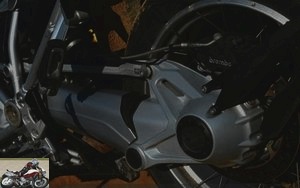
To calm the enthusiasm promised by the new Bavarian trail, four-piston radial calipers bite two 305 mm discs at the front. The opposite retarder is armed with a two piston element clamping a 276 mm fret. Everything is managed by a disconnectable integral ABS fitted as standard..
Finally, depending on the preferred terrain, we will choose between wheels with tangential radiation or multi-spoke aluminum (whose arms support the inflation valves). Dimensions 19 "front and 17" rear, the rims receive Metzeler Tourance Next wraps, respectively in 120/70 and 170/60, specifically dedicated to the R 1200 GS.
In the saddle
The BMW 1200 GS retains the dimensions in accordance with its legend. Saddle "altitude": 850 to 870 mm depending on the setting, simplicity, of the pilot seat: a plate to be reversed, a rocker to be swiveled. It will also be possible to adjust its inclination. The standard is ideal for my eighty-four meter and the high position is reserved for the ninety meter and more, especially off-road. No worries for the less tall an 820/840 mm low saddle and even a 790/810 mm lowering kit will accommodate their seat. If these values were not enough to reassure, finally know that the crotch arch is refined, further improving the support on the ground.
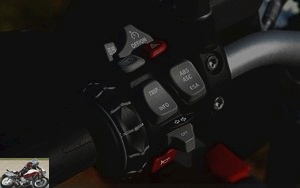
The accompanying person can also easily adjust his distance from the pilot. once perched on its large seat, flanked by respectable grab handles uniting as a package holder. This group is attached to a solid aluminum assembly including the optional case mounting spaces. Particularly ergonomic, the GS receives the crew with attention. The footrests are covered with rubber and their plates are perforated to receive the hooks of any packages. As for the saddles, their high resilience foam calls for no reproach just like their studied profile. We still regret the lack of storage space or storage space.
We find the house ergonomics, legs slightly bent and arms slightly apart by the wide handlebars with variable diameter. Strong saddles tie it to a no-frills triple tree, guiding the fork into a properly streamlined shaft. The eyes then fall on a neat cockpit, integrating the new dashboard style dashboard. Rather large, asymmetrical, it includes tachometer and analog tachometer, overlooking a good-sized monochrome digital window. And for good reason…. the information contained is plethoric. On the left: fuel gauge, gear indicator light, clock and especially the engine mapping selected via the "Mode" button. No less than five profiles are available: Dynamic, Road, Rain, Enduro and Enduro Pro (option). These functions, requiring a new "Throttle by wire" type throttle grip, influence the settings of the ABS, optional ASC anti-slip and ESA. (see Electronic summary)
In the right part, you will read the selected display, via the "Trip", "Info" and "ESA" buttons. The first concerns the odometer (total, two partial, range, customization) and the second includes Date, oil level, exterior and engine temperature, two consumption and average speeds as well as tire pressure (in the list of options) . The last allows the adjustment of the assisted damping according to 6 crossed variables: Hard, Normal, Soft and pilot alone, pilot and passenger, pilot and luggage.
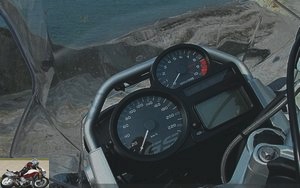
Despite everything, we will not forget other innovations, less sharp but innovative, such as a screen with a complex surface and its patented dial adjustment. The levers benefit from adjustment in spacing and the rotary selection dial appears on the left handle, controlling the optional GPS. The center stand is fitted to the default trail and mirrors, are easily adjusted and returns a wide and vibration-free image.
Fit and quality of fairings, finishes, paint…., The R 1200 GS offers almost flawless plastic. Certain welds of the frame and the junction of the tubes around the steering column, however, deserve more care..
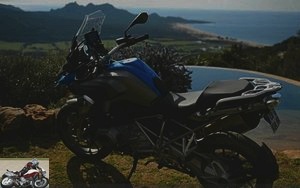
In the city
It is not without a certain impatience that we finally activate the new twin. Surprise, the exhaust "slams" like no other before on this range. In addition, the rotation of the motor is reversed and its reversing torque, already gradually erased from previous games, is now almost imperceptible. Finally, the engine takes its turns at the slightest request of the handle, with a total absence of inertia as yet unknown..

Even the first slap barely…. But for the rest, it’s a GS. Its 238 kg weight ready to cut the road, up 9 units, is forgotten as soon as the machine starts moving. Soft controls and balance at reduced speed quickly demonstrate that the Bavarian wader remains the benchmark in the field. Despite its respectable dimensions, the maxi trail naturally weaves its way through traffic, aided by an excellent turning radius. On the disappointment side, the instruments do not offer perfect readability, especially the screen whose contrast is too low in the sun.
The liquid block brings its share of differences. No longer available at low speed, its injection is also very gentle. And to leave the tricolor passed to green, the machine shows a new enthusiasm, leaping into a groan of super word ‘. But the twin also emits more various clicking noises than its predecessor. It nevertheless retains its incomparable smoothness and essential for fans of "flat" cylinders. Solicited with the tips of his gloves, he knows how to respond in the same way, with elegance and gentleness. Ideal in this urban environment, its flexibility allows recovery at 50 km / h on the last report. The revving is then done without downtime, to let the traveler go to wider horizons.
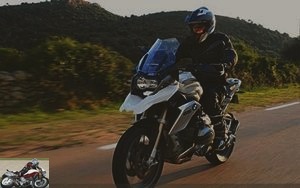
Motorway and expressways
Reaching the legal motorway in an instant, the speed stabilizes at 4,600 rpm in sixth. The time to activate the cruise control (take out a few more euros), we will then adjust the height of the bubble to the maximum. The protection is very good but leaves the shoulders in turmoil. Legs and torso are effectively protected, emphasizing the contribution of the deflectors surrounding the windshield and that of the scoops.
Despite its castration at 107 horsepower, the GS flaunts its new temperament but struggles to scour the last graduations of the tachometer. Nothing to complain about, at most to wish that 2016 arrives very quickly, like the 200 km / h mark that the German crosses in a furious breath. There is also a marked improvement in high speed stability. This will not prevent quickly taking an exit to test another point of the chassis.
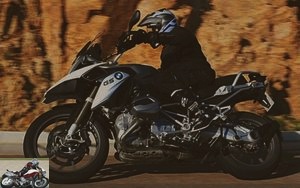
Departmental
In part, the raison d’être of the R 1200 GS and its success is played out on the secondary network. It is also the place to test engine maps and their multiple interactions with electronic aids. The small roads in the heights overlooking Ajaccio are sometimes wet and dirty. From Road, here I am in Rain. If the engine response does not seem drastically different (clamping obliges?), ABS, ASC and ESA show clear differences in their implementation. The damping set on Hard softens noticeably. The ASC is more intrusive, fortunately limiting some beginnings of square with hazardous consequences. Finally, the rear caliper, even more than usual, makes play the anti-lock.
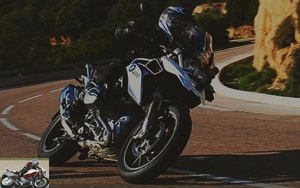
Back on healthier roads and in a hurry to do battle with the charming departmental, I select the Dynamic profile, giving the best of the engine. Here again, the choice effectively enslaves the vassals of part-cycle. Firmer, the suspensions prepare for the arson, the ABS tolerates more violent braking and the ASC plays the minimum service. What the back envelope underlines with a comma assassinates…. but controlled. There is no doubt that efficiency and overall safety are making a leap forward. What to drive more serenely on any occasion…. as long as we have made the adjustment adapted to the conditions encountered and desired piloting.
We finally discover the unusual song of its exhaust. Led at a frantic pace, the trail is now sporty, attacking the ferrule like little road machine. The twin responds almost violently in its liveliest mapping and with so much naturalness that more than one turn is tackled "a bit" quickly. It is then enough to increase the angle taking to pass the GS. You can also maintain the brakes on a curve without the machine straightening up or locking. A model of transparency and evidence. These frankly unbridled gaits are underlined by equally free vocalizations, forming an unusual song for its exhaust. Raucous, hectic, the voice of the flat now has accents of enduro machines. Almost too much in the long run.
The constant remains the extraordinary agility of the R 1200 GS. The last opus does justice to his brilliant genetics. Its widened rear tire of 20 mm only passes the extra power of the twin. Their name Next effectively predestines them to call each next turn. These effective compounds prevent them from dropping out that only engaged (or unsuitable) driving will trigger. Anti-skating also ensures their contact with the ground. Nothing therefore disturbs the handling of this machine. Not even potholes or other defects in the bitumen. The GS flies over all terrains AND all terrain.
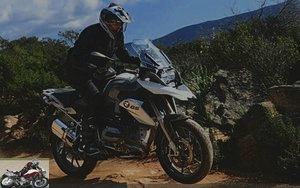
All Terrain
The second face of GS is indeed that of earth, even mud. It’s sandbox time. Switching to the rigorous Enduro mapping, limiting the ESA to Soft or Hard and we leave the saddle to adopt a Rally posture. From now on, the frank overshoots make the rear drift that the ASC leaves more free. ABS allows optimal decelerations on soft ground and motorcycles equipped with road tires (For pacifiers, use the Enduro Pro option).

However, deactivating these two aids allows you to make the best use of the trail. Likewise, choosing Hard damping increases efficiency tenfold excluding bitumen. The tires effectively handle the passage on a bumpy road despite their very road profile. A well-held challenge by the manufacturer loyal to the propeller brand.
Once again the GS gives the best, displaying unusual versatility. The availability of flat always enchants and allows you to evolve at low speed with a gear too much.
The tires effectively handle the passage on a bumpy road despite their very road profile. A well-held challenge by the manufacturer loyal to the propeller brand.
For the less seasoned, the increased power of the GS can be intimidating. The others will be happy to go even harder in the most unlikely places. Fans will meet at the next GS Days, a favorite playground for experienced adventurers.

Part-cycle
Rigid, with enhanced stability and traction, this R 1200 GS drives even better both on asphalt and on roads. The contribution of ESA electronics only reinforces its ever greater versatility.
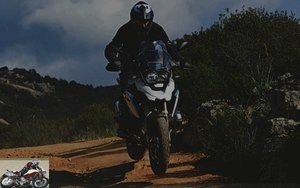
Braking
Progressive in powerful, one would ask, on road, more bite, in particular in mode Road and Dynamic. The feeling seems perfectible for the front system and calls for a less intrusive ABS on the rear wheel as the assistance is triggered quickly.
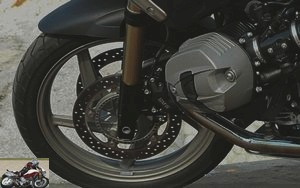
Comfort / Duo
The BMW gives pride of place to comfort, both for its driver and passenger. Ergonomics, soft stools, no diving during mass transfers…. the R 1200 GS is an ideal vessel. The over-raised position of the accompanying person may possibly hamper the older ones.
Consumption
The switch to liquid cooling does not change the appetite of the GS. 6.5 liters for 100 kilometers on average, 20 liters of tank…. enough to drive for a long time without going to the cash register…
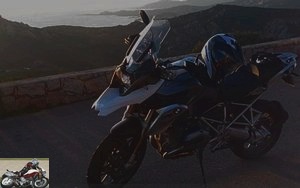
Conclusion
BMW is offering a key version of its iconic model. In addition to a complete modernization of its historic engine, the R 1200 GS 2013 also, more than ever, speaks electronics with mastery. The interaction of the various assistances shows excellent efficiency and brings a more sensitive in terms of safety and approval. More rigid, more balanced, more efficient and easier…. the 2013 GS allows almost everything to almost everyone. Lively and agile, its new twin-cylinder now gives it a more assertive character, assumed by a more sassy aesthetic, giving it the weapons to fight with the other tenors of the segment..
The Ducati Multistrada 1200 S Touring at € 19,990, Honda VFR1200X Crosstourer ABS at € 13,990, Triumph Tiger Explorer at € 14,890 and KTM 1190 Adventure + EDS TPMS priced at € 13,990 are thus designated. The exuberant Italian and her indecent cavalry will not remind the German off the road just like the heavy but versatile Honda. As for the Englishwoman, the phlegm of her engine and her audience now deserves to review their copy. Would the contender to the throne be Austrian? The latter may lack, in addition to public recognition and a too small network, the contribution of high-end cross-electronics..
The muse of Munich seems to have key assets to maintain its dominant position. Its revolution serves its hegemonic domination, strengthening its strengths. Remains a higher rate than its main rival. The Bavarian asks for € 15,150 (call price until March 2013) with ABS as standard. With the main options, ASC, ESA, heated grips, etc. the bill quickly rises from an additional 1,000 to 3,000 €. The price of undisputed versatility and iconic status that the toned mutant version only strengthens.
Strong points
- Motor
- Cyle party
- Finishes
- Interactive electronic assistance
- Aesthetic
Weak points
- Weight
- Instrument reading
- Exhaust sound level
- Unavoidable Option Packs
The R 1200 GS technical sheet
User tests on the
motorcycle test forum.
The opinions in the reviews and tests for the R 1200 GS
Competitors: Ducati 1200 Multistrada, Honda Crosstourer 1200, Honda XLV Varadero 1000, KTM 990 Adventure, Moto Guzzi Stelvio 1200, Triumph Tiger Explorer 1200, Yamaha 1200 Super Tenere
Colors
- Alpine White, Racing Red, Flame Blue and Metallic Thundergrey
Options and Packs
- Comfort pack: heated grips, RDC tire pressure indicator, hand guards, white LED indicators, suitcase holders (€ 655)
- Touring package: anti-slip ASC, ESA Dynamic, on-board computer, GPS preparation, chrome exhaust, heated grips, hand guards, white LED indicators, case holder (€ 1,430)
- Dynamic Pack: ASC traction control, ESA Dynamic, on-board computer, GPS preparation, LED lights, daytime running lights, white LED indicators (€ 2,115)
- Active Pack: ASC anti-slip, daytime running lights, cruise control, ESA Dynamic (€ 895)
- Essential Pack: Chrome exhaust, heated grips, RDC tire pressure indicator, cruise control, hand guards, luggage racks (€ 1070)
the case of cruise control, on-board computer, ESA Dynamic suspensions, five driving modes, heated grips, case racks, hand guards, lights – including daytime front lighting – and LED indicators, RDC tire pressure control system or ASC.
Technical
Maps
Five modes for the rider to choose from – “Rain”, “Road”, “Dynamic”, “Enduro” and “Enduro Pro”.
To adapt optimally to the needs of each rider and to the use he makes of his motorcycle, the new R 1200 GS now offers, as an ex-factory option, five maps that the rider can freely select. These profiles offer three different laws for the electronic throttle and therefore three different engine characteristics.
ASC (Automatic Stability Control) traction control,
Configured specifically for enduro, is coupled with these modes. When this option is chosen, BMW Motorrad ABS, ASC and, if so equipped, semi-active suspension, are adapted to the use profile of these five modes.
Semi-active dynamic ESA suspension
As an ex-works option, BMW’s new semi-active dynamic ESA (Electronic Suspension Adjustment) suspension offers the rider new possibilities for maximum safety and performance. Thanks to a front and rear travel sensor, the dynamic ESA captures several parameters, including the vertical movement of the front wheel guide and the rear wheel, to automatically adjust the damping to the conditions identified (depending on the pilot’s driving condition and maneuvers). Electrically controlled adjustment valves are responsible for adapting the front and rear shock absorbers.
Related articles
-
New reference Racer Tourer Long is the road traveled by the German road benchmark, driven by the famous flat twin. Indeed, the first model, R 100 RT,…
-
GS long haul The last representative of production machines dedicated to crossing the planet, if only for their style, the R 1200 GS Adventure makes the…
-
Yamaha Tracer 9 and Tracer 9 GT motorcycle test
Cross-country sprinters 3 cylinders in line, 889 cm3, 119 hp and 93 Nm, 213 kg full made, from 11,499 euros Road trail, sport-touring, road … the names…
-
Test Yamaha XT 1200 ZE Super Tenere
E. character slipper XT …, Tenere … some legends can be found in a few signs. In this case, that of Yamaha trails. Driven by the greatest rally…
-
Triumph Scrambler 1200 XC & XE test
Free spirit A dynamic leader in the neo-retro segment, Triumph draws novelty after novelty for 2019, articulated around its two twin cylinders of 900 and…
-
Aprilia Caponord 1200 ETV test
The return of the Caponord ETV but in version 1200, 12 years later The big trail signed Miguel Galuzzi Despite limited success, some of us will surely…
-
The way of Reason Teutonne Without going back to the genesis of the 30-year-old RT (Reise-Tourer) lineage, this road model sees its modern lineage dating…
-
A better course In 2013, Aprilia presented the heir to its first big Caponord trail, the ETV 1000 Caponord, which appeared 12 years earlier. Completely…
-
Suzuki Hayabusa motorcycle test
High speed phoenix (valid for its tester after a high-side) 4 cylinders in line, 1,340 cm3, 190 hp, 150 Nm, 264 kg, Euro5, 18,499 euros Hayabusa…. this…
-
Lady Tri After a first static presentation in Neukirchen, during the Austrian Tri-Days, the English manufacturer is finally offering its 1200 Trophy to…
very nice try
yes indeed I just did the configurator at BMW and it made 19,500 euros with the same equipment as the multi (suitcases and start-up etc …)
(suitcases and start-up etc …)
Yes, I have no action in anyone. I believe I have provided objective opinions, unless otherwise stated.
And I know these vehicles. All.
Now, depending on the use, I will not put them in the same order all the time..
But to come back to the Triumph, YES, the machine is fine.
But NO, apart from its price, it is not at the level of the GS. The price is important but when we talk about 15,000 Ђ entry level … it puts the possible future into perspective. Especially with the packs, once again, the German is interesting.
It’s like that and everyone is free to choose an excellent trail other than the GS. Yes Yes.